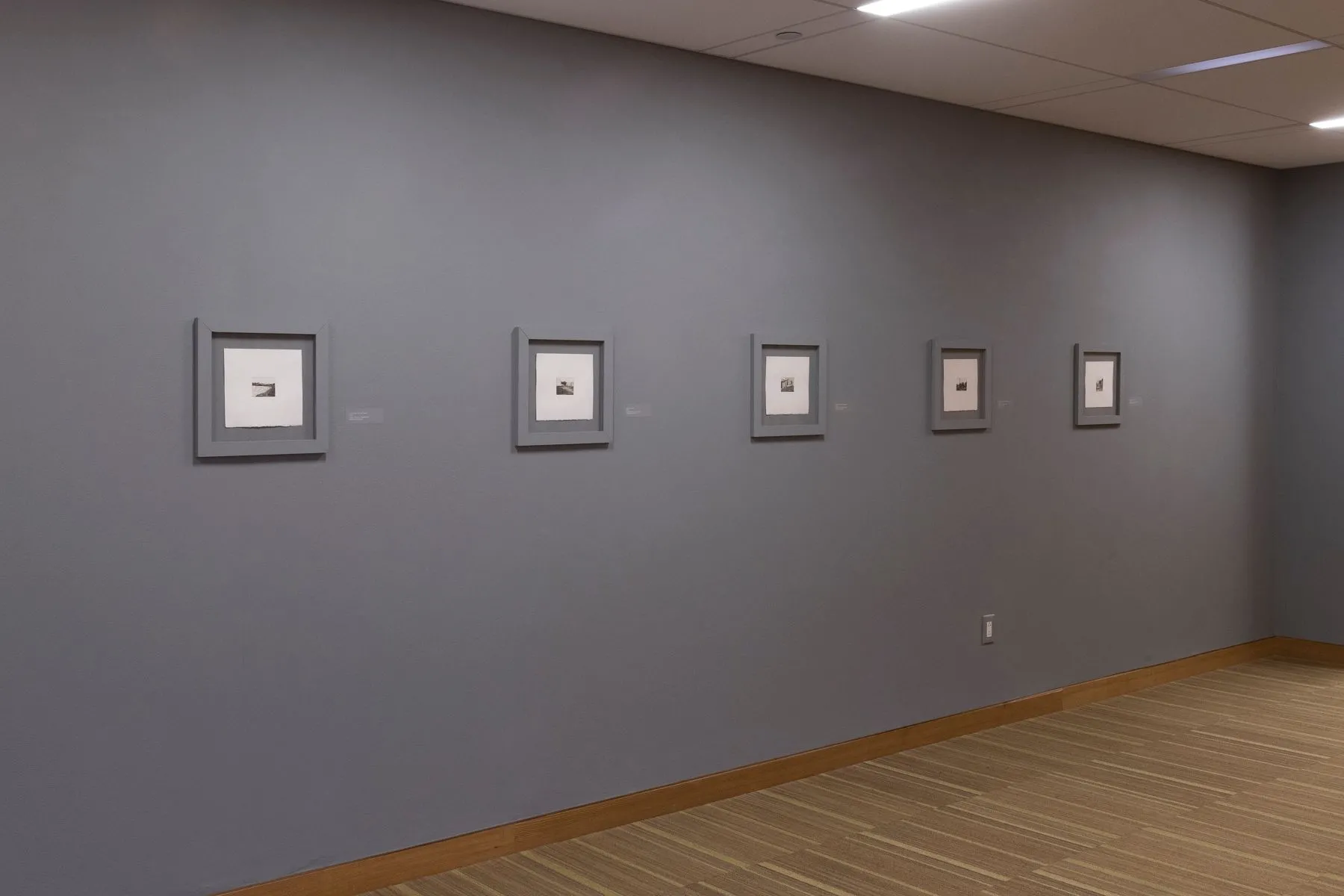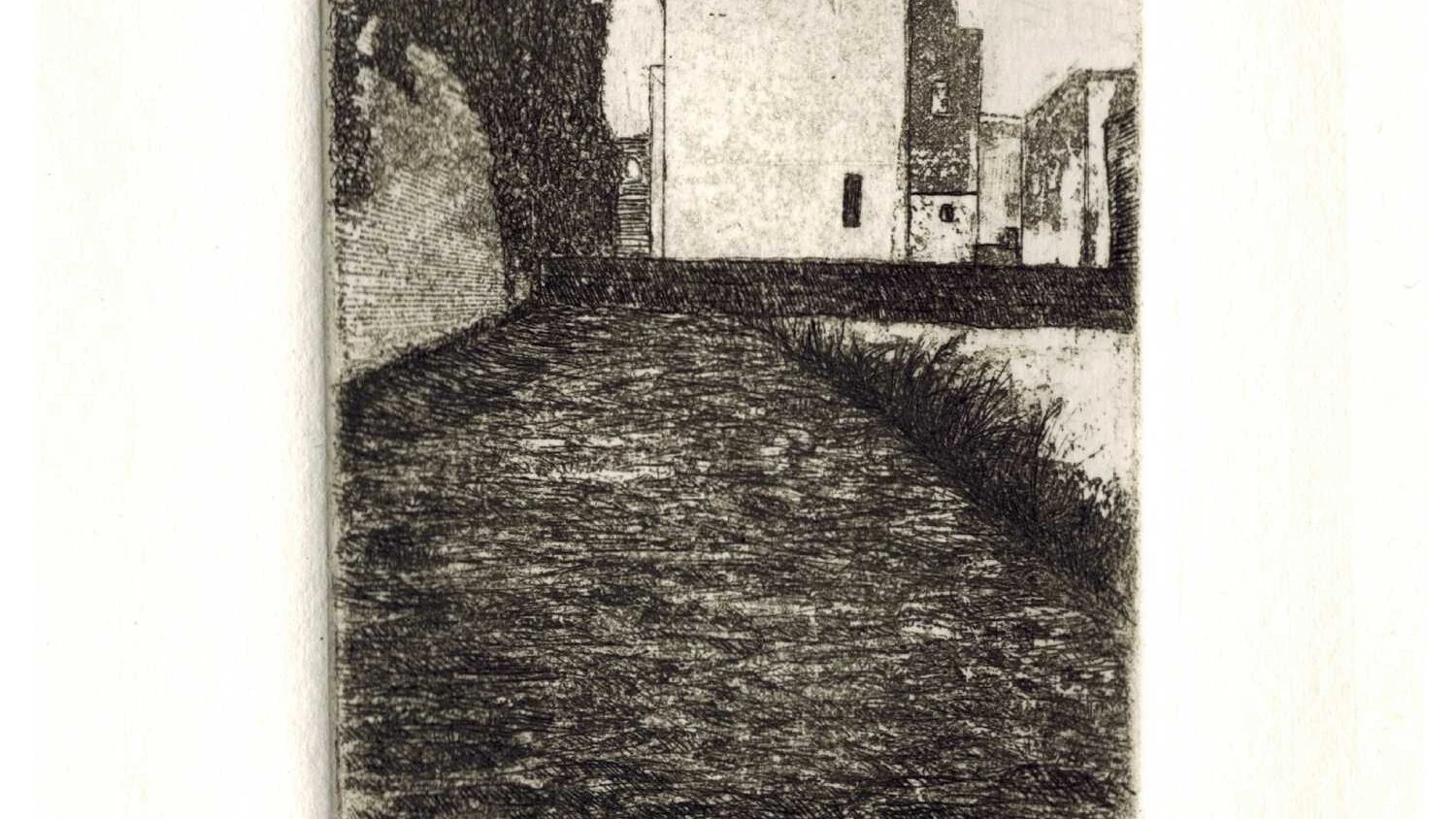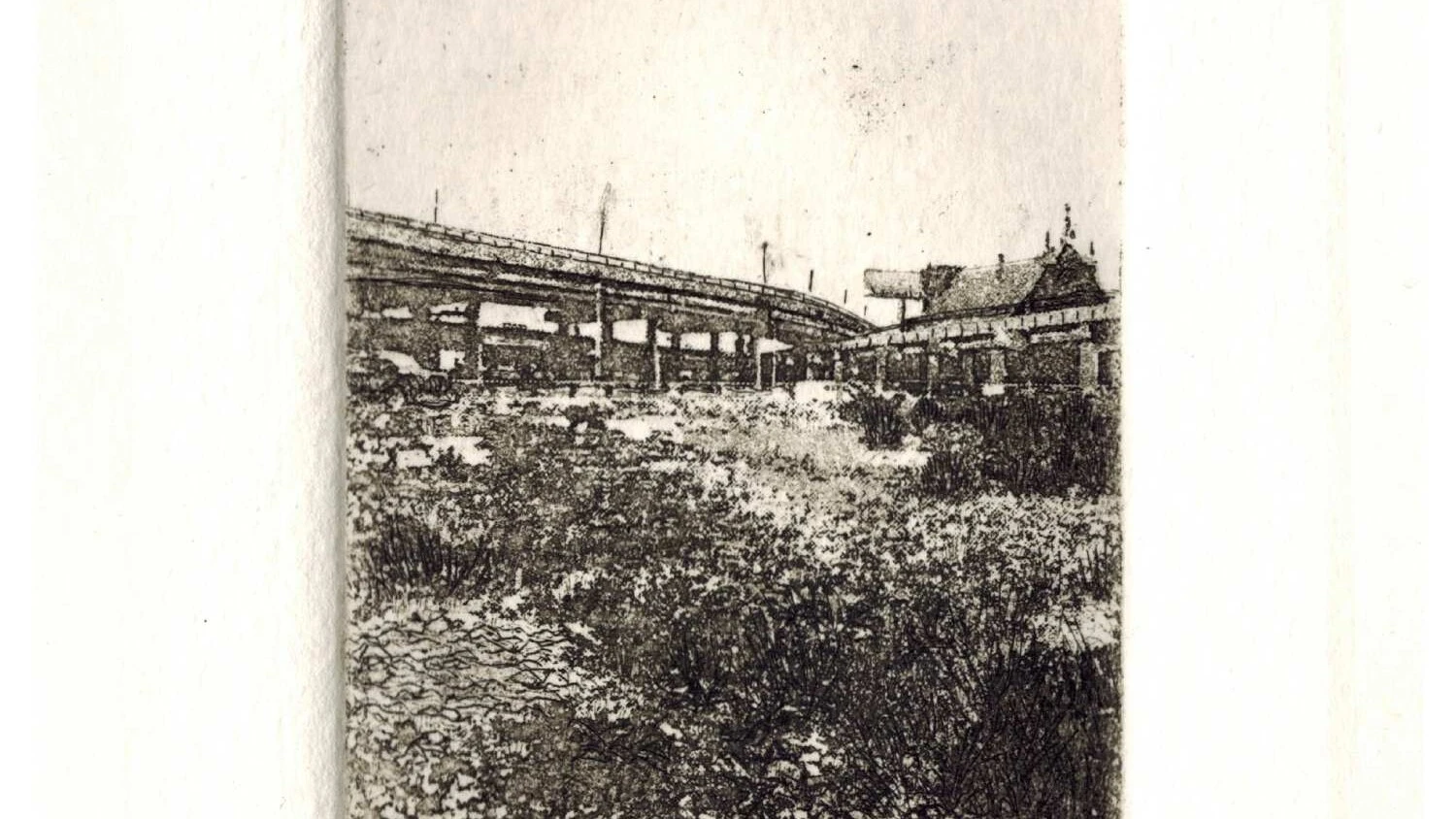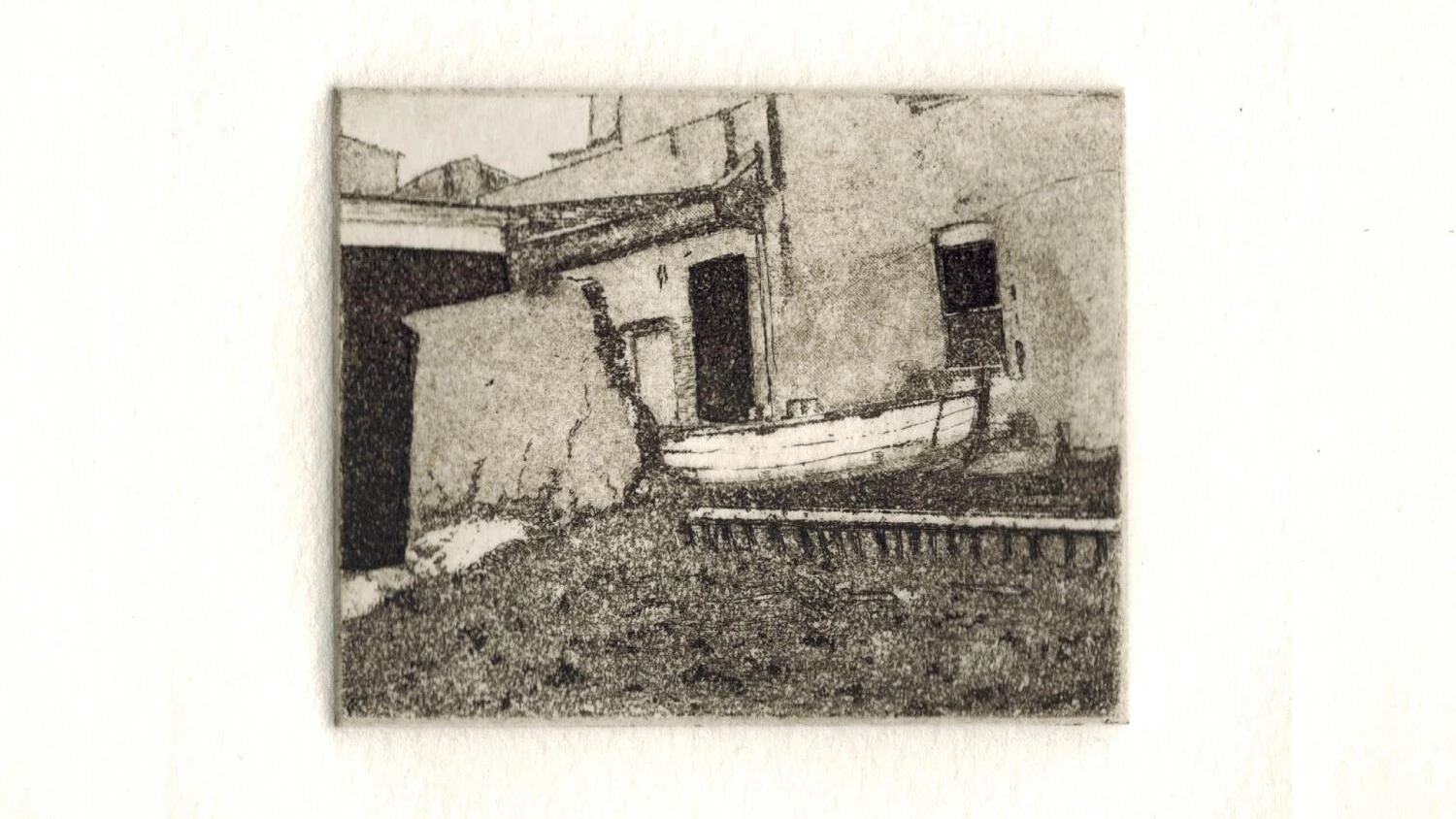April 15 – December 8, 2019
Rosedale Gallery
Arcadia Exhibitions is pleased to present “Jennifer Manzella: City Blocks” in the Rosedale Gallery from April 15 to December 8, 2019.

Installation view, "Jennifer Manzella: City Blocks", Rosedale Gallery, photo: Sam Fritch
The 15 intaglio prints on display in the Rosedale Gallery depict what Manzella refers to as “quiet spaces” that she discovered between buildings, near construction sites, and along the industrial waterfronts of the Delaware and Schuylkill Rivers while traveling by bike or on foot through the city of Philadelphia.
Working from her original photographs, Manzella etched these scenes into copper plates measuring 2 ¾” x 2 ½” with the height and width interchanging respective of vertical or horizontal composition. Her choice to explore the copper etching process at this compact size was spurred, in part, by the desire to duplicate the level of intimacy required to experience the landscape prints of Rembrandt van Rijn (1606-1669), which she encountered during a 2006 exhibition at the Georgia Museum of Art (Athens). Her ambition was to create works which would not only reward such close, careful looking but duplicate the outlay of time and care she puts forth while exploring her physical surroundings.
Aside from their scale, Manzella’s prints are actually quite distinct from those of the Dutch master in telling ways. According to scholar Nadine M. Orenstein, Rembrandt’s etchings tended to be “small and sketchy”, using expressive cross hatching, evocative of his drawing style, in order to build up value in his compositions. Manzella focuses more on tone and texture to evoke her subjects, achieved through a variation on the aquatint process. Used to add tonal range to etchings since the 17th century, aquatint involves applying an acid-resistant powdered rosin to targeted areas of the printing plate. When exposed to a chemical bath, the spaces around the granules etch away, producing a consistently textured surface that will hold ink for printing. The relative value of tone is controlled by the duration of the plate’s time in the acid bath. (Rather than traditional rosin, which must be heated to achieve adhesion to the plate, Manzella achieves a similar effect by applying spray paint to the copper.)
Additionally, Manzella’s depictions of gritty, seemingly forsaken neighborhoods are antithetical to Rembrandt’s idyllic, pastoral countrysides – though in her eyes, no less beautiful. Her prints unquestionably depict Philadelphia, but are clearly focused on a very particular aspect of the city. This is not the Philadelphia of the casual visitor – no Federal architecture, neo-classical museums, or Center City skyscrapers (except perhaps as incidental backgrounds). This is the city known to its residents – its neighborhoods and industrial areas – perhaps less grand and dramatic, but in no way lacking for character or history.






Jennifer Manzella, Second and Poplar, 2019, copper etching/intaglio print, 2 ¾ x 2 ½ inches, Courtesy of the artist
Jennifer Manzella, View From Susan's House: Wildey and Front, 2019, copper etching/intaglio print, 2 ¾ x 2 ½ inches, Courtesy of the artist
Jennifer Manzella, Beyond Voyage: Old Kensington, 2019, copper etching/intaglio print, 2 ½ x 2 ¾ inches, Courtesy of the artist
Jennifer Manzella, Second and Poplar, 2019, copper etching/intaglio print, 2 ¾ x 2 ½ inches, Courtesy of the artist
Jennifer Manzella, View From Susan's House: Wildey and Front, 2019, copper etching/intaglio print, 2 ¾ x 2 ½ inches, Courtesy of the artist
Jennifer Manzella, Beyond Voyage: Old Kensington, 2019, copper etching/intaglio print, 2 ½ x 2 ¾ inches, Courtesy of the artist
Art historian Lucy Lippard wrote that “travel is the only context in which some people ever look around. If we spent half the energy looking at our own neighborhoods, we’d probably learn twice as much.” Manzella seems to have internalized this insight. She spent twelve years as a professor living in or near Athens, Georgia, and spent many of her summers living and working in other locations for extended periods along the east coast of the United States, including New York and Maine. As a result, for much of her professional career, she has occupied environments simultaneously as resident and traveler. Her thoughtful recording of these experienced landscapes form the core of her artistic practice.
Since setting down roots in Philadelphia, either on her bike or on foot, she has continued to expend much energy exploring her adopted home in much the same way.
What seems to attract her attention, as documented in this series, are moments of absence – open areas, awash with the evidence of previous use, but now appearing abandoned. Stuccoed walls, chimneys, trees, bushes, or telephone poles appear in the backgrounds of her compositions. While they anchor each scene from a respectful distance, these structures are not her primary subjects. The distinction of the foreground goes to the relative emptiness of trampled grass, flat dirt, and piles of debris – depicted almost as oases among the unremitting blocks of rowhomes. Manzella renders these seemingly desolate spaces with great care and exhaustive detail, which ironically draws attention to how little notice they must normally receive.
Poignantly, many of the lots that Manzella has documented in this way are now sites of new construction, and so are no longer inactive. In a very deliberate sense these prints record the moment just before gentrification – a poignant protest to a loss of openness within a relentlessly unsentimental and pragmatic landscape.
ABOUT JENNIFER MANZELLA
Jennifer Manzella is an artist working primarily with relief and etching printmaking processes. Having earned an MFA in printmaking at The University of Georgia, she has worked as an art educator for over ten years. Manzella has shown her work in numerous national and international juried exhibitions, including twice at the International Print Center in New York City.
Manzella has been involved in several public art projects in New York City and Philadelphia, has been a recipient of an Andy Warhol Foundation Grant, and has undertaken several artist residencies including the Haystack Open Studio Residency at Haystack Mountain School of Crafts, Deer Isle, Maine.
Born in Wilmington, Delaware, and raised in Connecticut, she relocated to Philadelphia in the summer of 2016 after living in Athens, Georgia for 12 years. She currently teaches printmaking courses at Arcadia University, and is a member of BYO Print, a print cooperative in Philadelphia.
The exhibition is curated by Matthew Borgen, and was made possible by a donation from Theresa and John Rollins. For more information about these exhibitions, please contact Arcadia Exhibitions at (215) 517-2131 or borgenm@arcadia.edu.
PANEL DISCUSSION
April 18, 2019
A panel discussion featuring Manzella and photographer Tamsen Wojtanowski will be held in the University Commons Great Room beginning at 6:30 PM with a reception to follow. Both events are free and open to the public.

